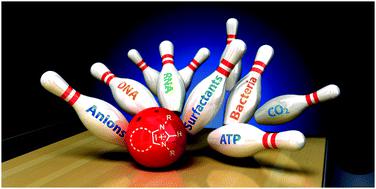当前位置:
X-MOL 学术
›
Chem. Soc. Rev.
›
论文详情
Our official English website, www.x-mol.net, welcomes your
feedback! (Note: you will need to create a separate account there.)
Revisiting imidazolium receptors for the recognition of anions: highlighted research during 2010–2019
Chemical Society Reviews ( IF 40.4 ) Pub Date : 2020-11-11 , DOI: 10.1039/d0cs00642d Ying Hu 1, 2, 3, 4, 5 , Shuangshuang Long 4, 6, 7, 8, 9 , Haiyan Fu 4, 10, 11, 12, 13 , Yuanbin She 1, 2, 3, 4 , Zhaochao Xu 4, 6, 7, 8, 9 , Juyoung Yoon 5, 14, 15, 16
Chemical Society Reviews ( IF 40.4 ) Pub Date : 2020-11-11 , DOI: 10.1039/d0cs00642d Ying Hu 1, 2, 3, 4, 5 , Shuangshuang Long 4, 6, 7, 8, 9 , Haiyan Fu 4, 10, 11, 12, 13 , Yuanbin She 1, 2, 3, 4 , Zhaochao Xu 4, 6, 7, 8, 9 , Juyoung Yoon 5, 14, 15, 16
Affiliation

|
Imidazolium based receptors selectively recognize anions, and have received more and more attention. In 2006 and 2010, we reviewed the mechanism and progress of imidazolium salt recognition of anions, respectively. In the past ten years, new developments have emerged in this area, including some new imidazolium motifs and the identification of a wider variety of biological anions. In this review, we discuss the progress of imidazolium receptors for the recognition of anions in the period of 2010–2019 and highlight the trends in this area. We first classify receptors based on motifs, including some newly emerging receptors, as well as new advances in existing receptor types at this stage. Then we discuss separately according to the types of anions, including ATP, GTP, DNA and RNA.
中文翻译:

再次审视咪唑鎓受体以识别阴离子:2010–2019年的重点研究
基于咪唑鎓的受体选择性地识别阴离子,并受到越来越多的关注。2006年和2010年,我们分别综述了咪唑鎓盐识别阴离子的机理和进展。在过去的十年中,该领域出现了新的发展,包括一些新的咪唑基序和鉴定了更多种类的生物阴离子。在这篇综述中,我们讨论了咪唑类受体在2010-2019年期间用于识别阴离子的进展,并重点介绍了该领域的趋势。我们首先根据基序对受体进行分类,包括一些新出现的受体,以及现阶段现有受体类型的新进展。然后我们根据阴离子类型分别讨论,包括ATP,GTP,DNA和RNA。
更新日期:2020-12-09
中文翻译:

再次审视咪唑鎓受体以识别阴离子:2010–2019年的重点研究
基于咪唑鎓的受体选择性地识别阴离子,并受到越来越多的关注。2006年和2010年,我们分别综述了咪唑鎓盐识别阴离子的机理和进展。在过去的十年中,该领域出现了新的发展,包括一些新的咪唑基序和鉴定了更多种类的生物阴离子。在这篇综述中,我们讨论了咪唑类受体在2010-2019年期间用于识别阴离子的进展,并重点介绍了该领域的趋势。我们首先根据基序对受体进行分类,包括一些新出现的受体,以及现阶段现有受体类型的新进展。然后我们根据阴离子类型分别讨论,包括ATP,GTP,DNA和RNA。











































 京公网安备 11010802027423号
京公网安备 11010802027423号